3. Science Goals and Expected Performance
It is assumed that a 1.4-m telescope is used with a coronagraph offering a 2 λ/D inner working angle, modeled after the PECO mission concept.
3.1. Primary Science Goals
The science goals of the astrometric camera are twofold:
- Assist the coronagraph to detect exoplanets. At the minimum, the astrometric measurement should confirm detections performed by the coronagraph and help constrain their orbital parameters.
- Measure the mass of all planets imaged by the coronagraph in the habitable zone of nearby stars
The PECO coronagraph system is adopted in this study. In this section, we estimate what astrometric measurement accuracy is required to achieve these goals. Figure 3-1 shows the list of stars around which Earth-like planets can be detected by PECO.
 |
Fig 3-1: List of stars around which Earth-like planets can be detected by PECO.
[png]
|
The mass estimation accuracy is function of planet type, stellar brightness (bright stars are easier, as their spikes are brighter in the astrometric camera) and star distance (stars further away produce a smaller astrometric signal). The list shown in Figure 3-1 shows the most challenging planets to be detected by PECO: Super-Earth and giant planets are easier to observe, both for the coronagraph and the astrometric camera. The faintest star in this list is mV = 3.7, and the most distant stars are at distances of 6.0, 6.1 and 7.5 pc.
A Sun analog at 6 pc from Earth is therefore a representative example of a challenging target for the coronagraph. Its apparent magnitude is mV=3.7, equal to the faintest target for which PECO coronagraph can detect a Earth analog. An Earth Mass planet is placed at 1.2 AU around this star (to avoid the 1 yr period blind spot with the astrometric measurement). For this target, the astrometric accuracy required to measure the planetary mass to 10% relative accuracy is derived in this section, and adopted as a requirement for the astrometric instrument.
The astrometric instrument is therefore designed to measure the mass of all targets imaged by the PECO coronagraph to 10% relative accuracy or better.
3.2. Measurement scheme
The planet orbit and mass are simultaneously measured by combining the astrometric and coronagraphic data, as illustrated in Figure 3-2.
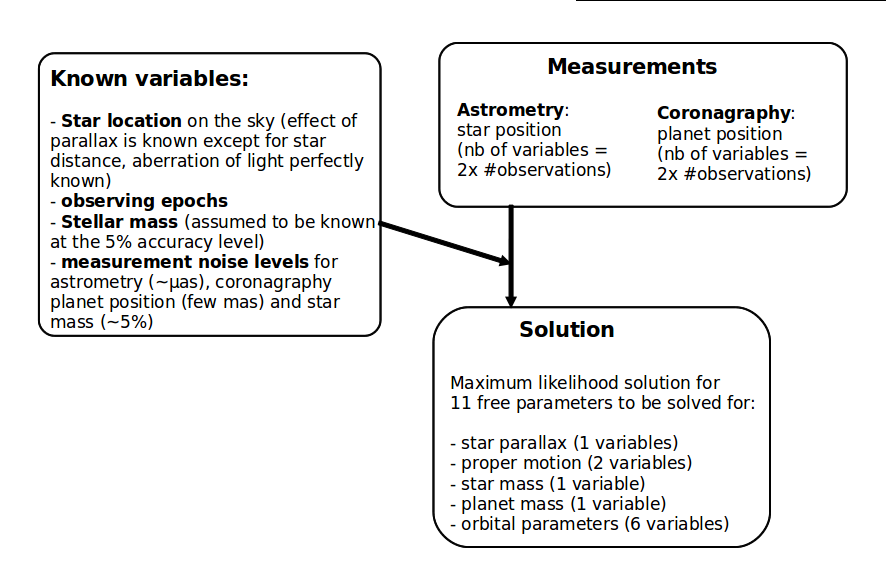 |
Fig 3-2: Combined astrometry and coronagraphy measurement principle.
[png]
The planet orbital parameters and mass are estimated by fitting both the astrometry and coronagraphy data.
|
Figure 3-3 lists the parameters used in the simulation to create the noisy input at the top of Figure 3-2. The fitting algorithm outlined in Figure 3-2 is then applied to obtain the best fit solution.
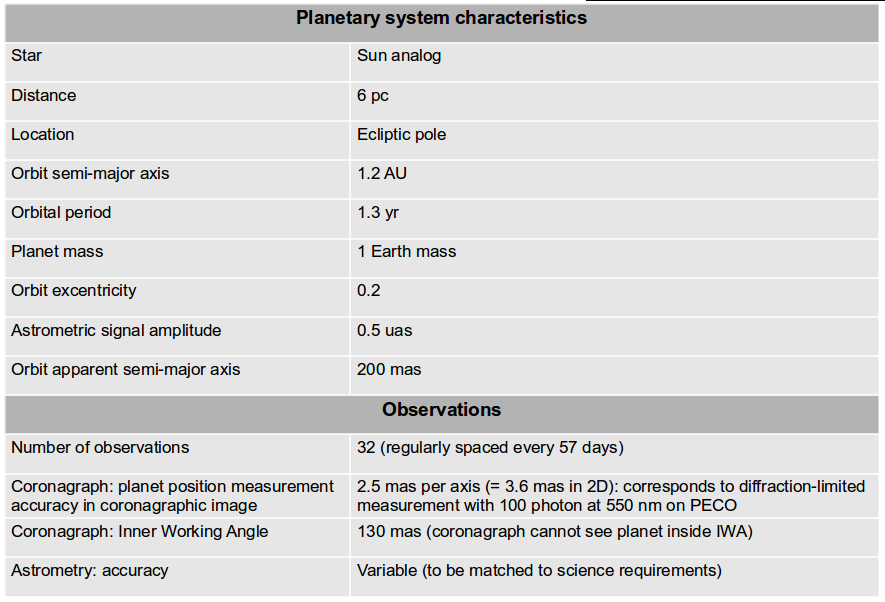 |
Fig 3-3: Simulation parameters.
[png]
|
Figure 3-4 shows the planet orbit geometry for the coronagraph.
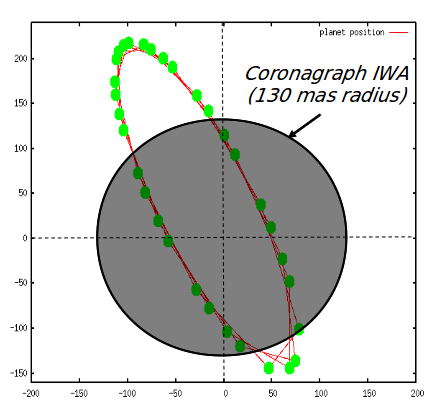 |
Fig 3-4: Planet orbit geometry in the coronagraph.
[png]
The planet is outside the coronagraph IWA for 17 out of the 32 observations.
|
3.3. Required astrometric measurement accuracy
3.3.1. Definition of astrometric measurement accuracy
The 1-D measurement accuracy is defined here as the standard deviation of a series of a series of 32 1-D astrometric measurement after parallax and proper motion have been fitted and removed from the 2-D astrometric measurements.
3.3.2. Measurement accuracy vs. Planet Mass measurement accuracy
To estimate the astrometric measurement accuracy required to meet science requirements, simultaneous coronagraphic and astrometric measurements were simulated and fitted according to the scheme shown in Figure 3.2. Figure 3-5 shows how the planet mass estimate changes as a function of the level of astrometric error per measurement, and shows that a 10% relative precision in the estimate of the Earth-mass planet requires a 0.2 μas accuracy per astrometric measurement.
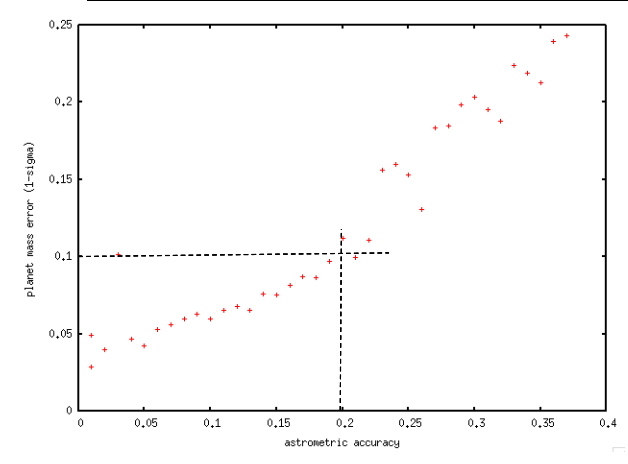 |
Fig 3-5: Mass measurement error as a function of astrometric single measurement accuracy.
[png]
To reach a 0.1 MEarth estimation error, the single measurement, single axis astrometric accuracy needs to be 0.2 μas.
|
3.4. Science benefits of simultaneous coronagraphic imaging and astrometric measurement
3.4.1. How coronagraphic imaging helps astrometry to measure planet mass
Coronagraph images provide an accurate measurement of the orbital parameters (more precise that astrometry), but no mass measurement. For a 1 MEarth planet on a 200mas radius orbit around a Sun-like star, a 2.5 mas position measurement accuracy in the coronagraphic image (~1/20 λ/D in the blue for a 1.4-m telescope) corresponds to 1/80 of the orbit radius, which is equivalent to a 0.007 μas astrometric precision.
[Note: The position measurement in the coronagraphic image is unlikely to be much better than ~2.5 mas (even with >> 400 photon) due to unknown residual speckle field and exozodi structures.]
As illustrated in Figure 3-6, solving for planet mass using the combined astrometry + coronagraphy measurements is therefore very powerful, and allows more accurate mass determination than would be possible with astrometry alone:
- The coronagraphic images contraint the orbital parameters and reduce error propagation from orbital parameter to mass estimate
- With both coronagraphic imaging and astrometry, the star mass is directly measured. The planet mass is therefore also directly measured (astrometry alone would only measure the planet to star mass ratio)
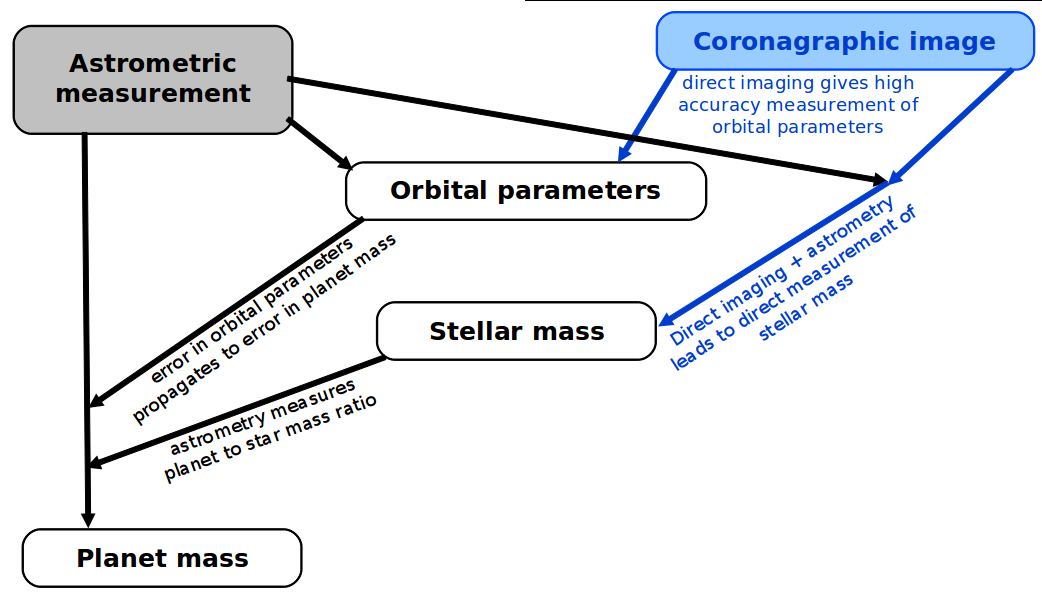 |
Fig 3-6: The complementarity between coronagraphic and astrometric measurements allows a better planet mass estimate than would be possible with astrometry alone.
[png]
|
Figures 3-7 to 3-9 illustrate the benefit of using both astrometry and coronagraphic images over astrometry only for the exoplanet system example adopted in this document (see Figure 3-3). Orbital parameters a much better constrained if coronagraphic images are used, even if the planet is only visible on a few observations.
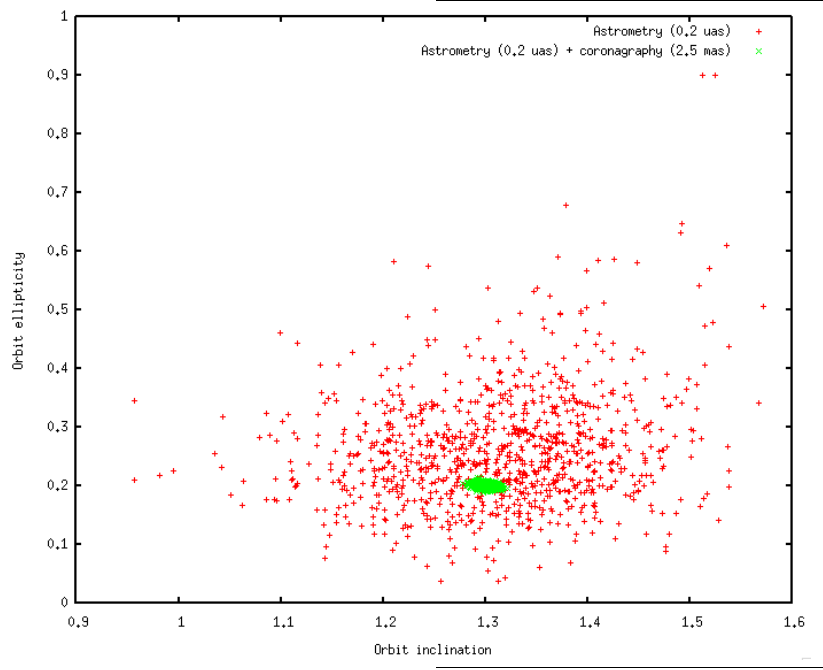 |
Fig 3-7: Comparison between astrometry alone and astrometry + coronagraphy: cloud of best fit solutions for orbit inclination and ellipticity.
[png]
|
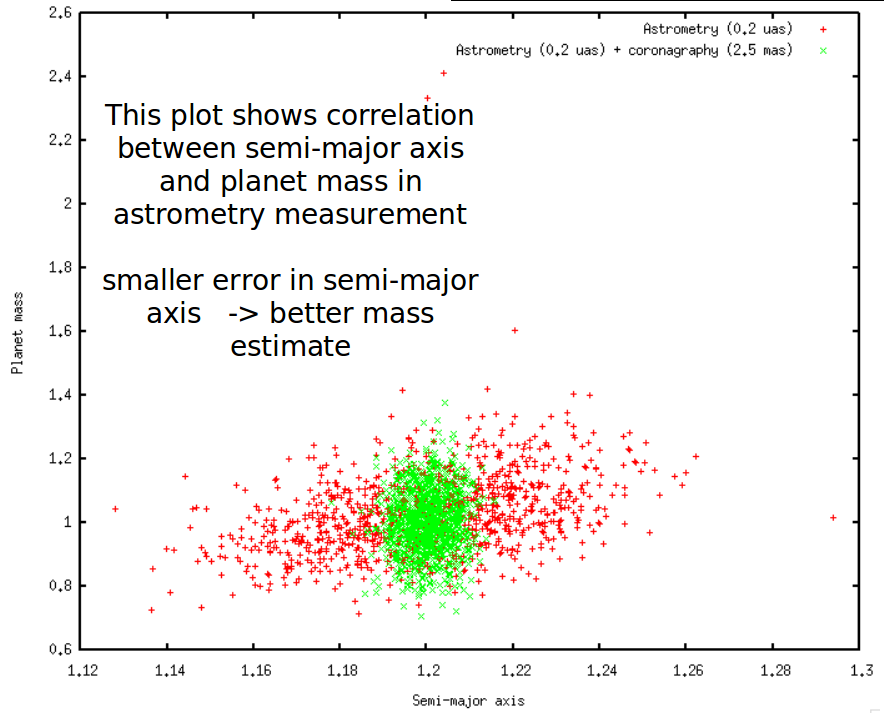 |
Fig 3-8: Comparison between astrometry alone and astrometry + coronagraphy: cloud of best fit solutions for planet mass and semi-major-axis.
[png]
|
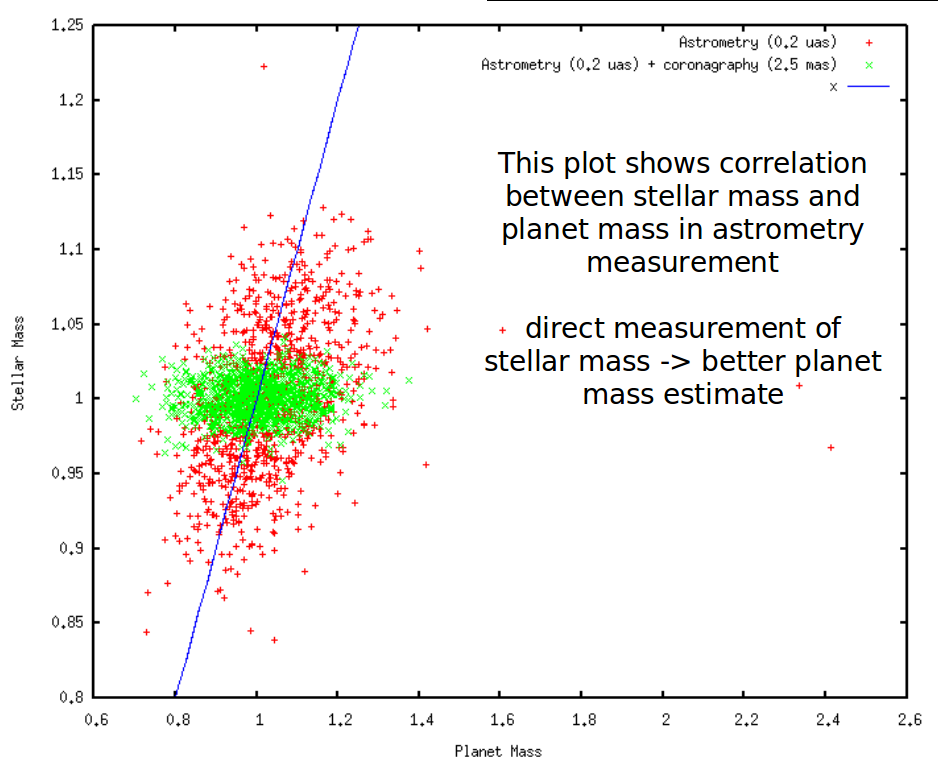 |
Fig 3-9: Comparison between astrometry alone and astrometry + coronagraphy: cloud of best fit solutions for planet mass and stellar mass.
[png]
|
The standard deviation for all parameters of the fit is shown in Figure 3-10, for both astrometry only and astrometry + coronagraphy. With coronagraphic images, the standard deviation on orbital parameters is reduced by approximately a factor 10, and the stellar mass is directly measured, while with astrometry only, it is assumed with a 5% standard deviation. The planet mass is estimated with a standard deviation below 0.1 MEarth with the combined data, while it would be 13% larger with astrometry only.
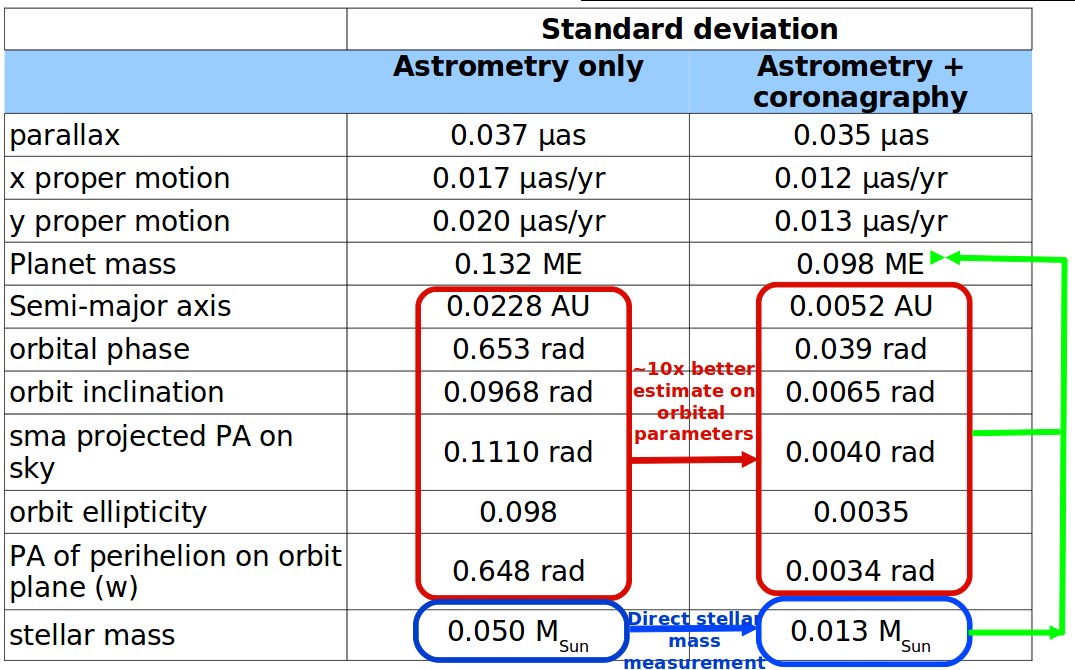 |
Fig 3-10: Comparison between astrometry alone and astrometry + coronagraphy: standard deviation for fit parameters
[png]
|
3.4.2. Improving mass measurement accuracy for planets with a nearly 1-yr period
The astrometric signature of a planet in a one year period orbit can be partially absorbed in the parallax fitting of the astrometry measurements. With astrometric measurements only, the mass estimate error therefore grows as the planet period becomes closer to 1yr for particular orbit geometries. The width of this blind spot is reduced as the astrometric measurements span a longer period of time. For a 5 yr mission duration, the astrometric blind spot covers approximately 5% of the habitable zone, so the detection rate is still good (approximately 95%) but is not 100%. With coronagraphic and astrometric data, the blind spot is reduced in size (although still not eliminated).
See email from M. Shao dated July 8, 2010, in the discussion section for a quantitative explanation of the astrometric blind zone.
To illustrate how coronagraphic images mitigate the astrometric blind spot problem, we consider here a 1 Earth mass planet at 1.01 AU from a Sun mass star (period = 1.015 yr) at the ecliptic pole, orbiting a star at 6pc. We assume circular orbits (for both the Earth and the target planet), and a planet orbit phase equal to Earth orbit phase plus 1 radian, with a face-on orbit. This is a particularly bad configuration which is unlikely to occur: it is used as an example to illustrate the blind spot mitigation thanks to coronagraphy, but is not a representative case of an habitable planet.
The system is observed 32 times over 5 yr with observations regularly spaced in time.
Results are as follows:
Astrometry only (0.3 μas error / per measurement):
Mass estimate (unit = Earth) = 3.25485 +/- 4.17483 -> Planet is not detected
Astrometry (0.3 μas error / measurement) + imaging (5 mas / measurement):
Mass estimate (unit = Earth) = 1.01314 +/- 0.161752
3.4.3. Broader benefits of a combined astrometry and coronagraphy measurement
Other benefits of performing astrometry and coronagraphy simultaneously include:
- Reduces confusion with multiple planets. Outer massive planets (curve in the astrometric measurement) will be seen by the coronagraph
- Astrometry will separate planets from exozodi clumps
- Astrometric knowledge allows to extract fainter planets from the images, especially close to IWA, where the coronagraph detections are marginal










